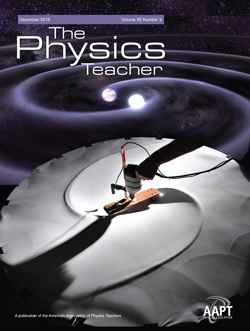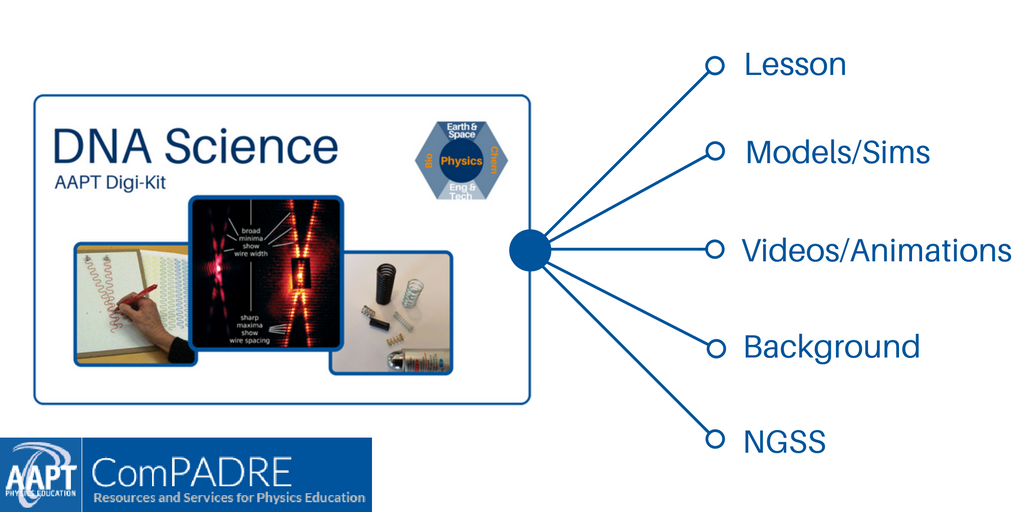The Physics Teacher
Volume 56 Issue 9, December 2018
Classroom Simulation of Gravitational Waves from Orbiting Binaries
This month's cover juxtaposes two almost inscruta-ble, yet weirdly similar images. Above we see an artist's rendering of gravitational waves produced by the inspiral of two white dwarf stars in four-dimensional spacetime (Source: https://www.youtube.com/watch?v=tU-piohbBv6o; Image credit: NASA GSFC/D. Berry). Below, we also see spiral waves on a spandex sheet, generated by a pair of orbiting caster wheels attached to a drill, and frozen in place by a strobe light.
Editorial
Sex, gender, and physics, and the introductory physics classroom by Gary White. DOI: 10.1119/1.5080565
Letters to the Editor
Pair-of-Sticks Hypothesis by Paul G. Hewitt. DOI: 10.1119/1.5080564
Columns
And the Survey Says..., Figuring Physics, iPhysicsLabs, Astronotes, Physics Challenge for Teachers and Students, Fermi Questions, Talkin' Physics, Technology in the Classroom, Tricks of the Trade, Visual Physics, and Websights.
Papers
Can the Energy of Fission Make a Grain of Sand Visibly Jump? by B. Cameron Reed. DOI: 10.1119/1.5080566
The Effect of Projectile Weight on the Optimum Launch Angle and Range by David L. Herrick. DOI: 10.1119/1.5080567
Classroom Simulation of Gravitational Waves from Orbiting Binaries by James Overduin, Jonathan Perry, Rachael Huxford, and Jim Selway. DOI: 10.1119/1.5080568
Curved Spacetime (Gravity) Tells Mass (Energy) How to Move by Elisha Huggins. DOI: /10.1119/1.5080570
Thermal Imaging Experiments as an Inspiration for Problem-based Learning by Petr Kácovský. DOI: 10.1119/1.5080571
The Color of the Sun – Perception and Spectral Density by B. H. Suits. DOI: 10.1119/1.5080572
Displaying Diverse Spectra Using a Thin White Line Screen (TWLS) by Robert Hobbs. DOI: /10.1119/1.5080573
Solar Cookers in the Physics Classroom by Rachael Lancor, and Brian Lancor. DOI: /10.1119/1.5080574
An Inexpensive Apparatus for Classroom Visualization of the Lift on Airplane Wings by Qingsheng Liang, and Yajun Wei. DOI: /10.1119/1.5080577
World’s Simplest Materials Lab by Austin D. Korff, and Alan J. Scott. DOI: /10.1119/1.5080578
Archimedes’ Principle Using Energy Considerations by Ker Liang Goh. DOI: 10.1119/1.5080579
An Arduino Investigation of Newton’s Law of Cooling by Calin Galeriu. DOI: /10.1119/1.5080580
A Reliable Wave Convention for Oppositely Traveling Waves by James Perkins, and Michael J. Ruiz. DOI: 10.1119/1.5080581
Frame in the Frame: Mystery Motion on the Hill by Mustafa Sahin Bülbül. DOI: 10.1119/1.5080582
Project Accelerate: Bringing AP® Physics 1 to Underserved Students by Mark D. Greenman, and Andrew Duffy. DOI: 10.1119/1.5080583
A Multilevel Seminar for Physics Majors: A Good Deal for Everyone by L. S. Dake, J. Ribaudo, and L. H. Day. DOI: 10.1119/1.5080584
Momentum Conservation Before Newton: Writing and Reasoning Activities for Introductory Physics Students by David L. Morgan. DOI: 10.1119/1.5080585
Driven Pendulum: An Advanced Experiment by Yaakov Kraftmakher. DOI: 10.1119/1.5080586
A Simple Experiment to Determine the Moments of Inertia of the Fidget Spinner by Video Analysis by V. L. B. de Jesus, and D. G. G. Sasaki. DOI: 10.1119/1.5080587
Additional Resources
Race and Physics Teaching Collection Resource
DNA Science Lesson & Digi-Kit
Inspired by an article from The Physics Teacher, this multidisciplinary lesson and digital resource collection is based on How Rosalind Franklin Discovered the Helical Structure of DNA: Experiments in Diffraction (Braun, Tierney, & Schmitzer, 2011). Click the image to access this resource.



